![]()
![]()
![]()
Use LEFT and RIGHT arrow keys to navigate between flashcards;
Use UP and DOWN arrow keys to flip the card;
H to show hint;
A reads text to speech;
51 Cards in this Set
- Front
- Back
|
Name at least 3 feline oral diseases. |
Periodontal disease Resorptive lesions Trauma Feline Lymphocytic Plasmocytic Stomatitis Neoplasia Eosinophilic Granuloma Complex Palatal Defects |
|
|
What percentage of cats have periodontal disease by the age of 6? |
85% |
|
|
Cats that have this done show 95% less calculus than the control group. |
Cats that have their teeth brushed twice weekly |
|
|
What is the most common disease of the tooth structure of the domestic feline? |
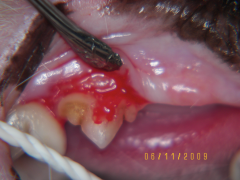
Resorptive Lesions |
|
|
50% of cats older than ______ have cavities. |
10 years old |
|
|
What is the average number of resorptive lesions in a cat? |
3 |
|
|
When were resorptive lesions first reported? |
1950s (properly recognized in the mid-late 1970's and appeared to be increasing in incidence) |
|
|
Can you name 4 signs of resorptive lesions? |
Varied depending on the stage of the lesion. Pain! Anorexia Ptyalism Lethargy Dysphagia Weight Loss Head Shaking Sneezing |
|
|
How many types (stages) of Resorptive lesions are there? |
5 Types (Stages) |
|
|
What Type (stage) of resortive lesions is signified by a lesion being into the cementum or enamel only? |
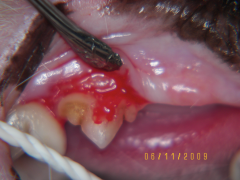
Type 1 |
|
|
What is the treatment for a Type 1 Resorptive lesion? |
Oral ATP (The root is planed thoroughly with a dental curette, polished with paste, dried, and given a fluoride treatment) |
|
|
What are 2 fluoride preparations? |
Fluoride varnish Fluoride-releasing dentinal-bonding agents Fluoride-releasing pit-and-fissure sealants Emphasis on home care |
|
|
If a resorptive lesion is through the cementum/enamel into the dentin, it is what type? (Stage) |
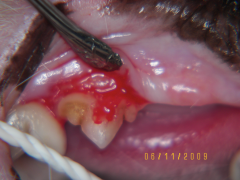
Type 2 (can still treat, start as type 1, then restoration) |
|
|
If a resorptive lesion is through the dentin and into the pulp cavity, it would be considered what Type? (Stage) |
Type 3 |
|
|
What is the treatment for a Type 3 resorptive lesion? |
Extraction Restoration Treat the Lesion Root canal is necessary |
|
|
What is a necessary treatment for a Type 3 resorptive lesion? |
Root canal |
|
|
What type (stage) of resorptive lesion would you have if you had extensive structural damage, and a fragile tooth? |
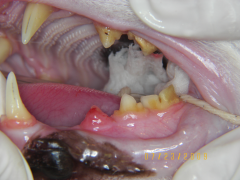
Type 4 |
|
|
What is the treatment for a type 4 resorptive lesion? |
Extraction |
|
|
What type (stage) resorptive lesion would you have if the crown is lost, but roots are still present? |
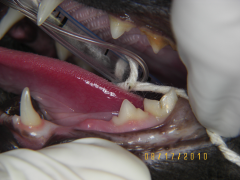
Type 5 |
|
|
What is the treatment for a Type 5 resorptive lesion? |
If the periodontal ligament is still present you must get the roots. However, if the resorption is involving 100% of the root surface, you don't need to go get the periodontal ligament. |
|
|
How often should you recheck after treating resorptive lesions? |
Recheck every 2 weeks, then recheck after that at 3-12 month intervals, and finally radiographs at 12 months post treatment.
You then want oral ATP's every year, and scaling by hand around the restorations. |
|
|
How can you reduce the risk/rate of resorptive lesions at home? |
Their diet makes a big difference (dry diets help reduce the rate of accumulation of plaque on the teeth, whereas raw liver and meat diets aggravate the condition). |
|
|
What are 2 factors that can aggravate resorptive lesions? |
Raw liver and meat diets aggravate the condition Chronic vomiting may also be involved |
|
|
What do we call Feline Lymphocytic Plasmocytic Stomatitis? |
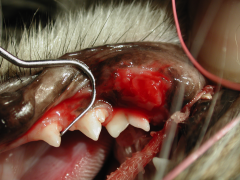
Feline Stomatitis |
|
|
What is the cause of Feline Stomatitis? |
Unknown |
|
|
What is/are implicated in the cause of feline stomatitis? |
Infectious agents (Bacterial and Viral) Immunologic capabilities are implicated This is not a distinct disease entity (uninhibited excessive immune inflammatory response) |
|
|
Feline Stomatitis is thought to be an "uninhibited excessive ______ ______ response." |
"Uninhibited Excessive Immune Inflamatory Response." |
|
|
The Bacterial component of feline stomatitis is thought to be caused by what type of bacteria? |
Bartonella |
|
|
What are some breeds that may be predisposed to have more severe feline stomatitis? |
Siamese Abyssinian Himalayan Persian Burmese Maine Coon (There may be an indication of genetic tendency also. In a study of 4858 cats, 0.7% (34)of all the cats showed a genetic tendency). |
|
|
What are 3 clinical signs of feline stomatitis? |
Ptyalism Halitosis Dysphagia Anorexia Weight loss Hyperemic, proliferative, ulcerative mucosa Commisures, glossophangyeal arches, and palate become involved |
|
|
How can you diagnose feline stomatitis? |
Clinical signs Biopsy |
|
|
True or False When treating Feline Stomatitis, if you use intense efforts at oral hygiene to control plaque, antibiotics to fight bacteria, and anti-inflammatory drugs, you will see good results in all of your patients. |
False. Even with these types of treatment, you may still fail to see good results in some patients. |
|
|
What are some treatment options for Feline Stomatitis? |
Elimination or control of excessive inflammatory response. Frequent Oral ATPs Home care If none of this is working you should extract the teeth. |
|
|
If you have treated an animal for stomatitis, and it shows no response to treatment, what should be done? |
Extract all teeth distal to the canines. |
|
|
If, after extraction of all teeth distal to the canines, you are still having trouble with Feline Stomatitis, what is indicated? |
Extraction of ALL of the teeth. |
|
|
If, after you have extracted ALL of the patient's teeth, and they are still experiencing trouble with feline stomatitis, what should be done? |
New trials of Interferon |
|
|
What is the fourth most common site of neoplasia in cats? |
Feline Oral Neoplasia |
|
|
The majority of feline oral neoplasias are benign/malignant. (choose one) |
Malignant |
|
|
What is the most common type of feline oral neoplasia? |
squamous cell carcinoma |
|
|
Where are the squamous cell carcinomas usually located in a cat's mouth? |
under the tongue (usually in cats over 10 years old, and either sex) |
|
|
How would you treat Oral squamous cell carcinomas? |
Wide surgical incisions (only in early lesions though!) |
|
|
What is the second most common feline oral neoplasia? |
Fibrosarcoma (however, they are relatively rare) |
|
|
Name 2 types of feline oral neoplasias. |
Squamous cell carcinoma Fibrosarcoma Melanosarcoma
|
|
|
What are ECG's also known as? |
Indolent ulcers or rodent ulcers (well circumscribed, ulcerative, red or brown lesions usually on the upper lip at the philtrum by the maxillary canines). |
|
|
Where are ECG's usually found? |
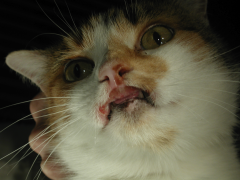
Usually on the upper lip at the philtrum by the maxillary canines. |
|
|
True or False Males are usually more commonly diagnosed than females with ECG's (by a factor of 2-3/1) |
False females are usually more commonly diagnosed than males. |
|
|
What is the average age of an animal that develops ECGs? |
9 months-9 years |
|
|
What is thought to cause ECG's? |
Thought to be inflammatory as a response to irritation such as trauma from a tooth, excessive grooming, allergies, and a possible link to squamous cell carcinoma. |
|
|
What is the treatment for ECGs? |
Steroids |
|
|
What are the most common teeth that get fractured in cats? |
almost always the canines, and incisors |
|
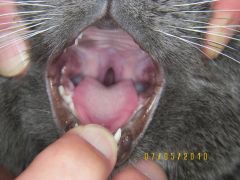
What does this picture show? |
cleft palate(palatal defects) |

